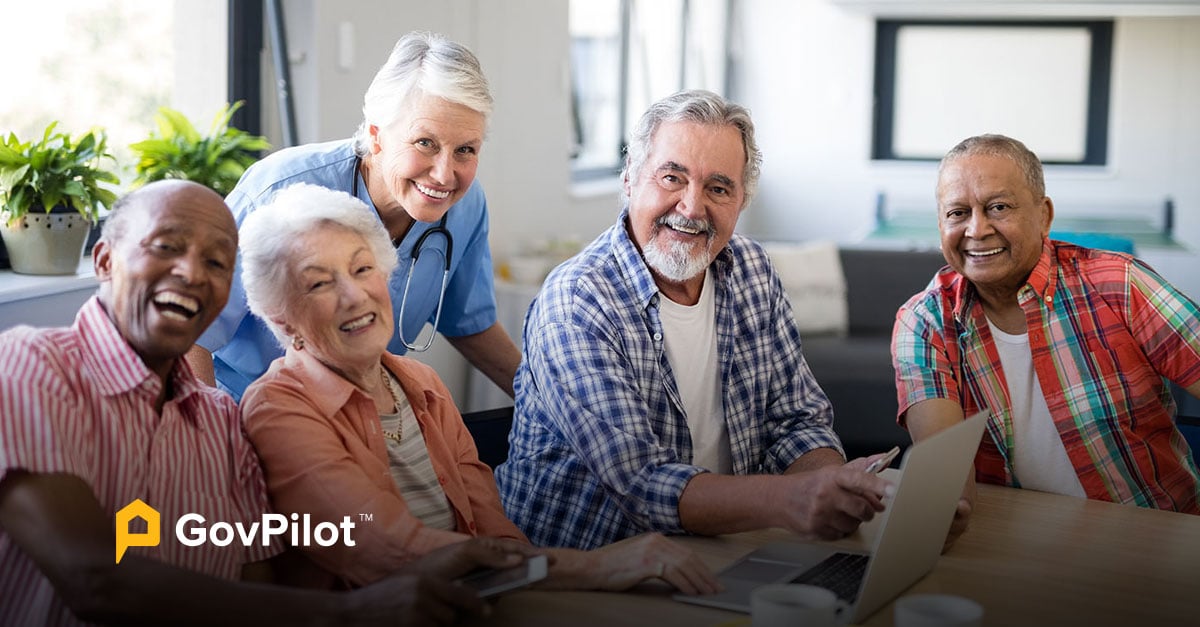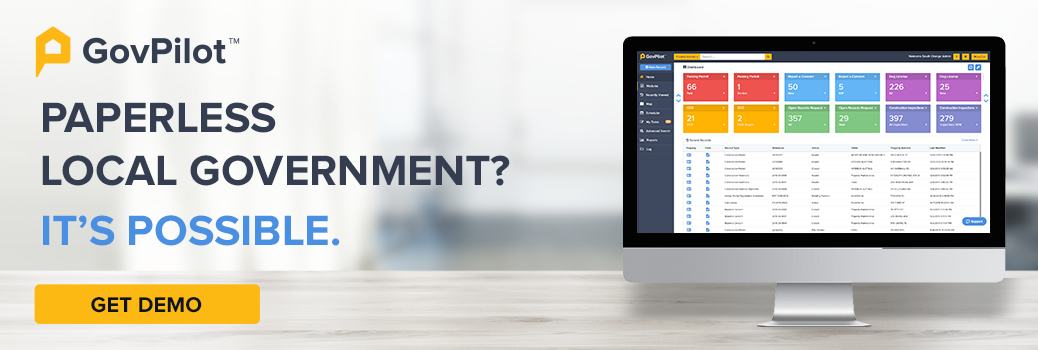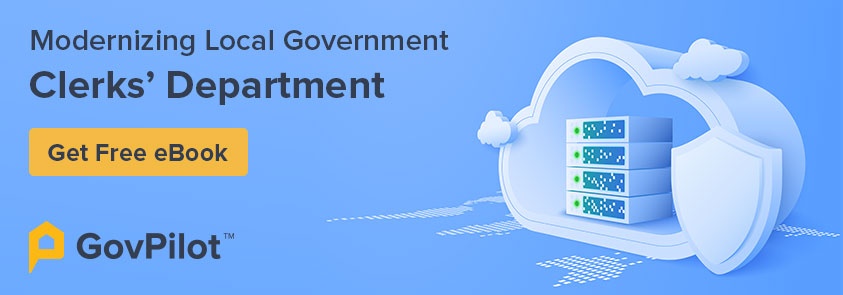As the baby boomer generation continues to age, local governments are facing a growing need to prioritize and protect their senior citizens. There are approximately 73 million baby boomers in the United States – all of whom will reach the age of 65 by 2030.
This growing group of senior citizens will have a significant impact on local governments as the need for essential services like healthcare, supportive resources, food, and housing increases.
And as more baby boomers retire each year, elderly constituents are positioned as key voter blocks in local government elections and affairs. Local governments must take action now to ensure the needs of a growing group of senior citizens are met now and in the future.
In this guide, we’ll explore the importance of a senior citizen management strategy for local governments. You’ll discover what a senior citizen management strategy should include, and how government technology can help localities keep their senior citizens safe and happy in their golden years.
What is a Senior Citizen Management Strategy in Government?
A senior citizen management strategy is a plan that local governments should have in place to support their senior citizens. Such plans should include key priority areas that are crucial for the well-being of seniors.
Priority areas differ based on the needs of an individual community, but they might include things like:
- Healthy aging
- Social well-being
- Isolation prevention
- Housing and emergency preparation
- Transportation.
Since numerous departments and organizations play a role in providing services to seniors, a senior citizen management strategy should incorporate all available local services. Having a written strategy promotes government accountability among all departments and government contractors that provide services to senior citizens such as the housing department and emergency management department.
These plans should also be reflective of the needs and priorities of a particular community and project the needs of seniors over time, taking into consideration funding and other necessary resources.
Why Local Governments Need to Prioritize Senior Citizens
As active and prominent taxpayers and voters in local elections, senior citizens are influential to election outcomes. With a growing number of retirees and seniors in communities, the needs of senior citizens will likely play a large role in local politics.
If it isn’t already, senior services will likely become a significant budget line item for many localities. As the provider of many senior services, local governments must begin prioritizing this influential group of citizens. Without a plan to guide these efforts, critical services may go unfunded, meaning critical resources will be unavailable to seniors when they need it most.
Read more about Creating Equity in Local Government Services.
Key Components of a Good Senior Citizen Management Strategy
How to Take Action to Protect the Elderly in Your Community
Government strategic planning for senior citizen management needs to include:
- Priority areas ranked by importance and immediacy. Budgets are tight for most localities, so it’s important to know how funding should be allocated based on the priorities of the community.
- Actionable strategies for each priority area. Describing the precise actions required to achieve the strategy not only helps guide the budget process, but also creates accountability to certain departments or outside organizations.
- Existing service providers in the area. Listing the available service providers in a community eliminates overlap and service redundancy. This also brings together the entire community into the plan, which helps create buy-in and accountability. Here are more ways Local Governments Can Partner with Private Contractors.
- List of available resources for senior citizens. While similar to sharing a list of available service providers, creating a list of resources may extend beyond senior specific services. Consider including things like childcare, disability assistance, therapy, or recreational opportunities. Since certain seniors are more tech savvy than others, you should have senior resources featured on your SEO & UX optimized government website and have physical copies accessible at various local government department locations in your community.
Steps to Create a Local Government Senior Citizen Management Strategy
A senior citizen management strategy should reflect the needs and preferences of the entire community. This creates a valuable document that can guide decisions for at least several years. Just know, the needs of the senior community will change over time, so local governments should consider updating their senior citizen management strategy at least every two years.
Here are the steps to take to create a senior citizen management strategy:
1. Gather input to determine key priority areas
- Send out a community survey to get feedback directly from senior citizens, their families, and caretakers. The best way to create a purposeful senior citizen strategy is to ask the community how they can be supported.
- Ask for input from social services, nonprofits, healthcare providers, and other organizations that support seniors in your community.
- Depending on how many seniors you serve, creating a task force may help to gather this input.
- Conduct internal analysis of historical data to determine what services have been most supportive in the past, and what programs didn’t work. Here’s How to Utilize Government Analytics to Make Informed Decisions.
- Research senior citizen management strategies of other localities and schedule calls to learn about what worked and what didn’t to measure actual performance against government KPIs.
- Register seniors in the community who are experiencing age related disabilities such as dementia, early onset Alzheimer's or other physical impairments. This will help police and other first responders locate and interact with a senior citizen who becomes lost or disoriented.
2. Conduct a needs and resources assessment
- Determine how many senior citizens your community will have in 3, 5, 10, 15, and even 20 years. These projections will help guide resource allocation and local population management.
- Once the key priorities are finalized, identify service and resource gaps. If there is a priority area that is under-resourced, this is a good time to flag it for further discussion.
- Create a task force to oversee the development of any new programs or initiatives.
3. Estimate funding needs and include projections in future budgets
- Determine what funding and resources your local government can allocate to senior services, and what services outside organizations may be able to take on. Take into consideration any new priority areas and existing services.
- Project the anticipated costs of services over the next decade or two. Align these projections with the key priority areas defined by the community.
Read more about Allocating Budgets Across Local Government Departments.
4. Develop partnerships.
- Although local governments are often expected to fund and operate social services, sometimes these services are better managed by outside organizations.
- Creating and nurturing partnerships with businesses, nonprofits, state programs, healthcare providers, and even local universities can go a long way to creating a sustainable senior citizen management strategy.
How Government Technology Can Help with Senior Citizen Management
Providing accessible and robust senior services is only possible with a strong senior management strategy and streamlined operations. The needs and preferences of senior citizens will continue to grow and evolve, so local governments must be prepared to respond quickly and effectively.
With government administration software, like GovPilot, local governments can better coordinate senior services within a community. Using a single government operating system to coordinate efforts of all departments and organizations involved with providing services to seniors creates efficiencies and reduces redundancies. All data is stored in the local government cloud for simplified access.
Government technology such as community planning and zoning software and GIS Maps can be used to make decisions around improving access to key resources near retirement communities and senior care homes. Knowing where resources are allocated and where gaps exist translates into better planning – and ultimately better service to seniors.
Local governments can improve response time for senior care requests when using the right technology. Digitizing processes can save agencies considerable time and resources. Consider upgrading your technology with GovPilot to access:
- Senior citizen registration
- Intuitive online forms for non-tech savvy citizens
- Online reporting for elderly abuse
- Public health data storage for simplified and access to health information for the elderly on a cyber secure government platform.
Get more insight into Modernizing Government Data Storage in this helpful resource.
Use GovPilot for Better Senior Citizen Management and Beyond
With the help of government technology, local governments can develop strong senior citizen management strategies to meet the growing needs of senior citizens in the coming decades.
If you’d like to learn more about how GovPilot can improve your senior citizen management, book a demo today.
Government Senior Citizen Management FAQs
What is a Local Government Senior Citizen Strategy?
A government senior citizen management strategy is just what it sounds like; government departments need to have strategic planning procedures in place to assist and protect the elderly members of their community.
Critical components of senior citizen management planning include accessibility to critical information that applies to seniors, public-private sector partnership with businesses that provide services for the elderly, budget planning for government services & infrastructure for seniors, and government communications with elderly members of the community for honest feedback about issues to prioritize for senior citizens.
Can Grants Help With Senior Citizen Management?
The federal government recognizes key challenges local governments face with managing an aging population, and is providing financing for state and local governments as a result. As highlighted in a tweet by Texas Rep. Dennis Bonnen, “TX… secured $16.2M in federal funds to provide meals for senior citizens during the… pandemic.” This is just one example of both state and federal dollars being used to ease economic and accessibility burdens faced by the elderly in the wake of COVID-19.
Here are more grants that can make life easier for your local senior population and entirety of your community:
- US Infrastructure Investments & Jobs Act: What It Means for Local Governments
- American Rescue Plan Act: What It Means for Local Governments
- Federal Cybersecurity Grants to Keep Local Government Data Secure
- NJDOH Health Grants for Local NJ Governments
- Florida Cybersecurity Grants for Local Governments Program: A Guide for FL Local Governments
- BEAD Broadband Grants for Rural Local Governments
Read on for more helpful Government Trends & Tech Resources:
- Public Space Planning Tips for Local Governments
- Local Government Revenue Generation Sources & Tips
- Engineering Department Strategy for Local Governments
- Improving Public Transportation at the Local Level
- Tips for City Managers & Administrators Around City Planning
- Tips for Public Health Directors to Consider About Modern Public Health
Sources:








